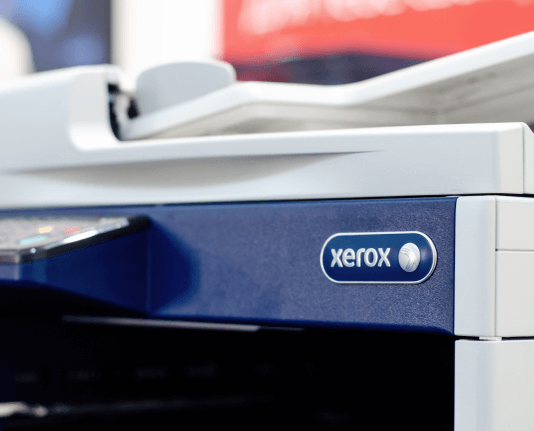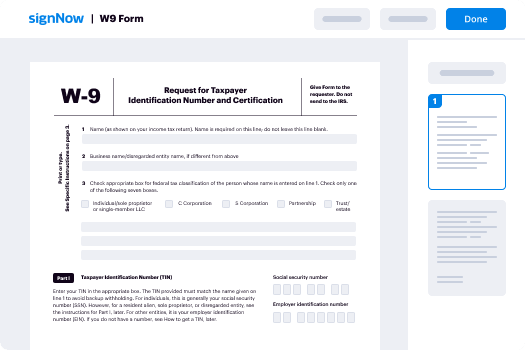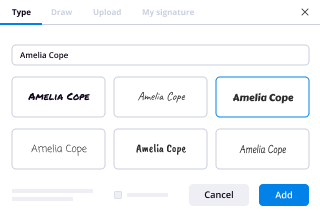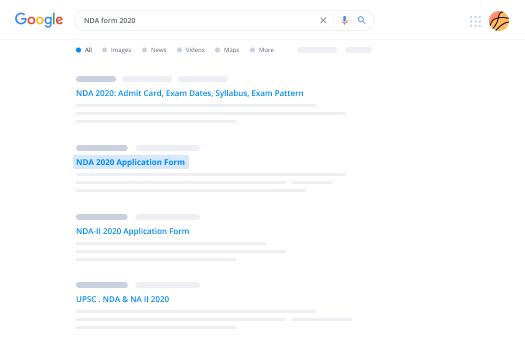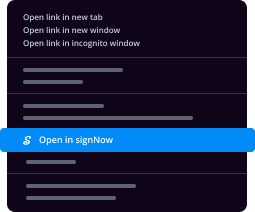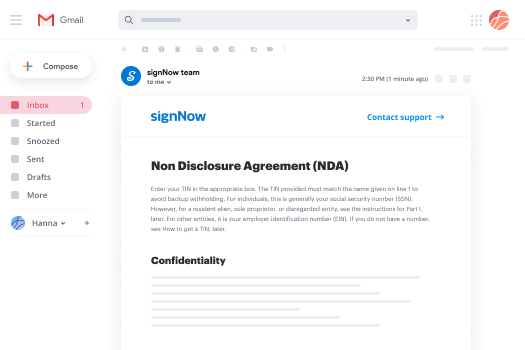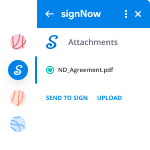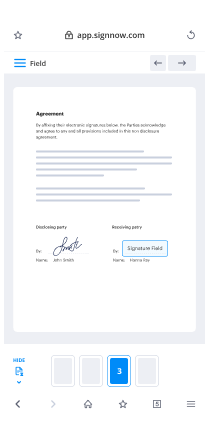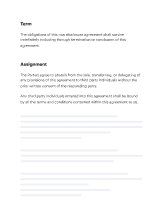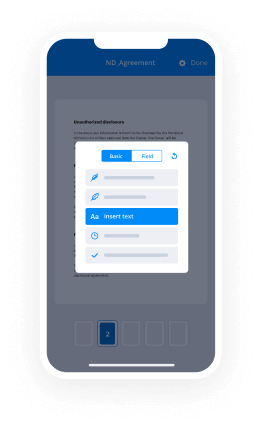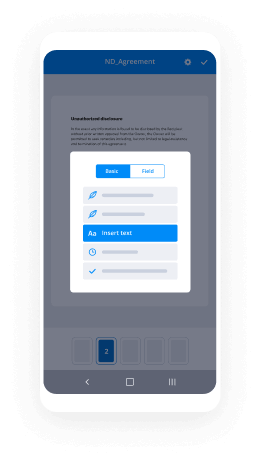Can I Install Sign in Oracle
Contact Sales
Make the most out of your eSignature workflows with airSlate SignNow
Extensive suite of eSignature tools
Discover the easiest way to Install Sign in Oracle with our powerful tools that go beyond eSignature. Sign documents and collect data, signatures, and payments from other parties from a single solution.
Robust integration and API capabilities
Enable the airSlate SignNow API and supercharge your workspace systems with eSignature tools. Streamline data routing and record updates with out-of-the-box integrations.
Advanced security and compliance
Set up your eSignature workflows while staying compliant with major eSignature, data protection, and eCommerce laws. Use airSlate SignNow to make every interaction with a document secure and compliant.
Various collaboration tools
Make communication and interaction within your team more transparent and effective. Accomplish more with minimal efforts on your side and add value to the business.
Enjoyable and stress-free signing experience
Delight your partners and employees with a straightforward way of signing documents. Make document approval flexible and precise.
Extensive support
Explore a range of video tutorials and guides on how to Install Sign in Oracle. Get all the help you need from our dedicated support team.
Keep your eSignature workflows on track
Make the signing process more streamlined and uniform
Take control of every aspect of the document execution process. eSign, send out for signature, manage, route, and save your documents in a single secure solution.
Add and collect signatures from anywhere
Let your customers and your team stay connected even when offline. Access airSlate SignNow to Install Sign in Oracle from any platform or device: your laptop, mobile phone, or tablet.
Ensure error-free results with reusable templates
Templatize frequently used documents to save time and reduce the risk of common errors when sending out copies for signing.
Stay compliant and secure when eSigning
Use airSlate SignNow to Install Sign in Oracle and ensure the integrity and security of your data at every step of the document execution cycle.
Enjoy the ease of setup and onboarding process
Have your eSignature workflow up and running in minutes. Take advantage of numerous detailed guides and tutorials, or contact our dedicated support team to make the most out of the airSlate SignNow functionality.
Benefit from integrations and API for maximum efficiency
Integrate with a rich selection of productivity and data storage tools. Create a more encrypted and seamless signing experience with the airSlate SignNow API.
Collect signatures
24x
faster
Reduce costs by
$30
per document
Save up to
40h
per employee / month
Our user reviews speak for themselves






Eloqua Access: Your Manual for Utilizing airSlate SignNow
If you seek a smooth method to handle your document signing requirements, airSlate SignNow is a robust platform that can assist. With its intuitive interface and economical solutions, you can effortlessly send and sign documents online. By adhering to the steps outlined below, you can swiftly get started with your airSlate SignNow account and reap its advantages.
Eloqua Access: Instructions to Utilize airSlate SignNow
- Launch your browser and head to the airSlate SignNow website.
- Establish a free trial account or log into your current account.
- Select the document you would like to upload for signing.
- If you intend to use this document later, save it as a template.
- Access your uploaded document, making necessary modifications such as adding fillable fields or inserting information.
- Authenticate the document and include signature fields for the recipients.
- Click on Continue to set up and send your eSignature invitation.
In summary, airSlate SignNow equips businesses with an effective and cost-efficient solution for sending and signing documents. With its extensive feature set, you can anticipate a signNow return on your investment.
Prepared to optimize your document signing process? Log in to airSlate SignNow today and discover how simple it can be to manage your eSignatures!
How it works
Browse for eloqua login
Try oracle cloud sign in
See oracle documentation works
Rate sign in oracle
-
Best ROI. Our customers achieve an average 7x ROI within the first six months.
-
Scales with your use cases. From SMBs to mid-market, airSlate SignNow delivers results for businesses of all sizes.
-
Intuitive UI and API. Sign and send documents from your apps in minutes.
A smarter way to work: —how to industry sign banking integrate
FAQs
-
What is the process for an eloqua login on airSlate SignNow?
To perform an eloqua login on airSlate SignNow, navigate to the login page and enter your credentials. Make sure you have an active account with the correct username and password associated with your Eloqua account. Once logged in, you can easily access all the features of airSlate SignNow.
-
Is there a cost associated with using airSlate SignNow after an eloqua login?
AirSlate SignNow offers various pricing plans that cater to different business needs. After your eloqua login, you can explore these options and choose a plan that fits your budget. Each plan provides access to essential features for document signing and management.
-
What features can I access after my eloqua login?
After completing your eloqua login, you will gain access to a wide range of features including eSignature capabilities, document templates, and real-time tracking of your documents. These features are designed to streamline your document workflow and enhance productivity.
-
Can I integrate airSlate SignNow with other applications after an eloqua login?
Yes, after your eloqua login, you can integrate airSlate SignNow with various applications such as CRM systems, cloud storage services, and more. This integration allows for a seamless workflow, making it easier to manage documents across different platforms.
-
What benefits does airSlate SignNow provide for businesses after an eloqua login?
After your eloqua login, businesses can enjoy signNow benefits including reduced turnaround time for document signing, enhanced security features, and easy collaboration with team members. These advantages help to streamline operations and improve overall efficiency.
-
How secure is my information during the eloqua login process?
The eloqua login process on airSlate SignNow is secured with industry-standard encryption protocols. We prioritize the security of your data, ensuring that all information exchanged during the login and signing processes remains confidential and protected.
-
What should I do if I forget my password for eloqua login?
If you forget your password for the eloqua login, you can easily reset it by clicking on the 'Forgot Password?' link on the login page. Follow the instructions sent to your registered email to create a new password and regain access to your account.
-
What's something that you should never say to an I.T. person?
“Backups? What do you mean, ‘Backups’”?“Oh, yeah, I saw that thing asking me to update my computer. I just closed it.”Variants: “Oh, yeah, I saw that thing asking me to update my anti-virus. I just closed it. Did I do something bad?”“Oh, yeah, I saw that thing asking me to start the backup of my computer. I just closed it. Did I do something bad?”“Oh, yeah, I saw that thing telling me not to reboot my computer. I rebooted anyway. Did I do something bad?”“Oh, yeah, I saw that thing telling me not to turn off my computer. I did it anyway. Did I do something bad?”“Where is the ‘any’ key?”“You mean that email, offering a million dollars if I clicked the link? Of course I clicked it! Who doesn’t want a million dollars?”“You have no idea what you are doing!”Variants: “You’re an idiot”“How’d you become a computer tech? You’re so incompetent!”“My 7-year-old could do a better job than you!” (So why isn’t your seven year-old here now fixing your computer? Oh, right he’s behind a year in kindergarten doing ‘nap-time’ just now).— and then I fix the computer anyway.“Pay you? But you didn’t fix the computer the ‘right’ way!” (Usually said because the client is a cheapskate and chiseller, and doesn’t want to pay the bill).“But we’ve always done it that way!” (usually, obsoletely, inefficiently, or even incompetently).“The last tech did it differently” (So why isn’t HE here doing the work?)“Can I watch?” (No).“Have you tried … ?” (This can actually be helpful, once in every 20 times it’s said).“I know you spent an extra three hours, but can I just pay you for the first hour?” (Why? Are you a cheapskate?).“I prefer paying for MS Office than for that ‘free’ LibreOffice. If it’s free, it’s probably no good.” (Really? You want to pay for mediocre software?)“Ubuntu? What the hell crap software is that?” (Written ON THIS SITE by a die-hard Windows fanboy).“Linux is junk” (Yeah? Why does it run 70–80% of the Internet?)“signNow Flash is really beneficial to websites” (Said by a VERY new web-designer)“Windows is better than Linux/BSD/UNIX” (No comment).“WIndows is the best software in the world! It’s extremely secure and very unlikely to crash” (Again, no comment).“No-one uses Linux any more” (Again, Yeah? Why does it run 70–80% of the Internet?)“I know you’ve been working really hard to fix my computer; could you just please do …..” (Note to self: be prepared to do at least a dozen more tasks — for free).“Oh, thanks for your work in fixing my computer. But [long pause] … I don’t have any way to pay you. Can I pay you $5 every other month?” (She owed me $105; At that rate, she’d have paid me off in three-and-a-half years).“I have a ______ computer that’s ___ years out of date. Can you fix it with new parts?”(Said by an MCSE student): “Hey, when the 90-day version of Windows Server runs out, how do you reinstall it?” (What the HELL are you going to classes for? And what sort of crappy school is it that doesn’t teach its students how to install server software to future system administrators?)Etcetera, etcetera, etcetera.
-
Is Hortonworks or Cloudera Better for Hadoop Certification? Which has more credibility? What are the differences?
Either. But why don't you go with MapR instead?I have experience with Cloudera training & certification, (which was great, but I'm sure it cost my company quite a lot of money then, given it was classroom training and they had to get Cloudera trainers from abroad). The tag of being a Cloudera Certified Developer for Apache Hadoop definitely certainly gave me confidence and some sense of satisfaction, but I guess what eventually mattered was I got a way to learn Hadoop well.However, not every company (or individual) can afford to pay for such training. Also there isn't much flexibility with time or resources for the learning process.MapR, one of the top ranked Hadoop distributions, offers free on-demand training (see Hadoop On-demand Training Courses). They have a wide variety of courses and the course material is detailed and I found them a bit more interesting (they have some new concepts on FileSystem side, ...) . I've completed a few and it was lot easier to manage my learning. I had the freedom of choosing my time and the topic I wanted to focus on. They have follow-up quizzes after each lesson and eventually one could register for certification.I think this would be a better way to go.p.s. I currently work for MapR. But these are my personal thoughts and based on experiences from before.
-
How can I install Oracle in Ubuntu 16.4 lts?
What product you want to install of Oracle (company) ? Their JDK, Database, MySQL or anything other.Please provide the product name.
-
How can I install Oracle 11g in Ubuntu 16.04LTS?
Installing JavaWe start with installing Java on the machine. My personal preference is to use Oracle Java JDK. Installing this JDK could be done easily by performing the following statements.123sudo add-apt-repository ppa:webupd8team/javasudo apt-get updatesudo apt-get install oracle-java7-installerThe screen in figure 1 will appear in the terminal, hit enter to proceed. After this, the screen in figure 2 will be shown. Navigate to
using the left arrow on your keyboard and hit enter. Oracle JDK 7 will be installed.Figure 1: Binary Code licenseFigure 2: JDK License AgreementTo validate the Java installation, execute the following command:1java -versionThis should result in the following (or something similar).123java version “1.7.0_51”Java(TM) SE Runtime Environment (build 1.7.0_51-b13)Java HotSpot(TM) 64-Bit Server VM (build 24.51-b03, mixed mode)The next next step is to set the JAVA_HOME environment variable. To do this, open the /etc/bash.bashrc file by executing the following statement.1sudo gedit /etc/bash.bashrcScroll to the bottom of the file and add the following lines.12export JAVA_HOME=/usr/lib/jvm/java-7-oracleexport PATH=$JAVA_HOME/bin:$PATHSave the file and close the editor. To load the changes, execute the following statement.1source /etc/bash.bashrcTo validate the changes you can execute the following statement.1echo $JAVA_HOMEThe result of this statement should be the following.1/usr/lib/jvm/java-7-oracleInstalling Oracle 11g R2 Express EditionFor the installation of Oracle 11g R2 Express Edition (XE), a couple of additional Linux packages are required. These packages can be installed by executing the following statement.1sudo apt-get install alien libaio1 unixodbcThe next step is to download the Oracle 11g R2 Express Edition from the Oracle website. Make sure you select the Linux x64 version from http://www.oracle.com/technetwor.... After the download is completed, open the terminal and navigate to the download directory. In my case this can be done by executing the following statement.1cd DownloadsThe next step step is to unzip the downloaded file. To do this, execute the following command.1unzip oracle-xe-11.2.0-1.0.x86_64.rpm.zipA new directory (Disk1) is added to the Download directory. Navigate to this directory:1cd Disk1Now we have to convert the Red Hat package (rpm) to a Debian package. This may be done using the alien command. The -d parameter is used to inform alien that a Debian package should be generated. When the -scripts parameter is toggled, alien will try to convert the scripts that are meant to be run when the package is installed and removed.1sudo alien --scripts -d oracle-xe-11.2.0-1.0.x86_64.rpmThis step may take a while, while this statement is executing we can do the following steps. Open a new terminal window for these steps.The Red Hat package, relies on the /sbin/chkconfig file, which is not used in Ubuntu. To successfully install Oracle XE we use a simple trick. Start by creating a custom /sbin/chkconfig file by executing the following statement.1sudo gedit /sbin/chkconfigCopy and paste the following into the editor:12345678910111213141516#!/bin/bash# Oracle 11gR2 XE installer chkconfig hack for Ubuntufile=/etc/init.d/oracle-xeif [[ ! `tail -n1 $file | grep INIT` ]]; thenecho >> $fileecho '### BEGIN INIT INFO' >> $fileecho '# Provides: OracleXE' >> $fileecho '# Required-Start: $remote_fs $syslog' >> $fileecho '# Required-Stop: $remote_fs $syslog' >> $fileecho '# Default-Start: 2 3 4 5' >> $fileecho '# Default-Stop: 0 1 6' >> $fileecho '# Short-Description: Oracle 11g Express Edition' >> $fileecho '### END INIT INFO' >> $filefiupdate-rc.d oracle-xe defaults 80 01#EOFSave the file and close the editor. Now we have to provide the file with the appropriate execution privileges.1sudo chmod 755 /sbin/chkconfigAfter this, we have to create the file /etc/sysctl.d/60-oracle.conf to set the additional kernel parameters. Open the file by executing the following statement.1sudo gedit /etc/sysctl.d/60-oracle.confCopy and paste the following into the file. Kernel.shmmax is the maximum possible value of physical RAM in bytes. 536870912 / 1024 /1024 = 512 MB.12345# Oracle 11g XE kernel parameters fs.file-max=6815744 net.ipv4.ip_local_port_range=9000 65000 kernel.sem=250 32000 100 128 kernel.shmmax=536870912Save the file. The changes in this file may be verified by executing:1sudo cat /etc/sysctl.d/60-oracle.confLoad the kernel parameters:1sudo service procps startThe changes may be verified again by executing:1sudo sysctl -q fs.file-maxThis method should return the following:1fs.file-max = 6815744After this, execute the following statements to make some more required changes:123sudo ln -s /usr/bin/awk /bin/awkmkdir /var/lock/subsystouch /var/lock/subsys/listenerClose the second terminal window and return to the first terminal window. The rpm package should be converted and a new file called oracle-xe-11.2.0-2_amd64.deb have been generated. To run this file, execute the following command:1sudo dpkg --install oracle-xe_11.2.0-2_amd64.debExecute the following to avoid getting a ORA-00845: MEMORY_TARGET error. Note: replace “size=4096m” with the size of your (virtual) machine’s RAM in MBs.123sudo rm -rf /dev/shmsudo mkdir /dev/shmsudo mount -t tmpfs shmfs -o size=4096m /dev/shmCreate the file /etc/rc2.d/S01shm_load.1sudo gedit /etc/rc2.d/S01shm_loadCopy and paste the following in the file. Note: replace “size=4096m” with the size of your machine’s RAM in MBs.12345678910#!/bin/shcase "$1" instart) mkdir /var/lock/subsys 2>/dev/nulltouch /var/lock/subsys/listenerrm /dev/shm 2>/dev/nullmkdir /dev/shm 2>/dev/nullmount -t tmpfs shmfs -o size=4096m /dev/shm ;;*) echo errorexit 1 ;;esacSave the file, close the editor and provide the appropriate execution privileges.1sudo chmod 755 /etc/rc2.d/S01shm_loadConfiguring Oracle 11g R2 Express EditionIf you have successfully installed to Oracle 11g R2 Express Edition server, it’s time to configure the server. To start the configuration of the server, execute the following command and follow the “wizard” in the terminal. Default values are shown between brackets for each question.1sudo /etc/init.d/oracle-xe configureNow it is time to set-up some environmental variables. Open the /etc/bash.bashrc file by executing the following statement:1sudo gedit /etc/bash.bashrcScroll to the bottom of the file and add the following lines.123456export ORACLE_HOME=/u01/app/oracle/product/11.2.0/xeexport ORACLE_SID=XEexport NLS_LANG=`$ORACLE_HOME/bin/nls_lang.sh`export ORACLE_BASE=/u01/app/oracleexport LD_LIBRARY_PATH=$ORACLE_HOME/lib:$LD_LIBRARY_PATHexport PATH=$ORACLE_HOME/bin:$PATHSave the file and close the editor. To load the changes, execute the following statement:1source /etc/bash.bashrcTo validate the changes you can execute the following statement.1echo $ORACLE_HOMEThis statement should result in the following output.1/u01/app/oracle/product/11.2.0/xeAfter this step it is recommended to reboot the machine. After the reboot is completed, you should be able to start the Oracle server using the following command:1sudo service oracle-xe startA file named oraclexe-gettingstarted.desktop is placed on your desktop. To make this file executable, navigate to you desktop.1cd ~/DesktopTo make the file executable, execute the following statement.1sudo chmod a+x oraclexe-gettingstarted.desktopInstalling SQL DeveloperFinally, after the installation of Oracle 11g R2 Express Edition and Java, SQL Developer could be installed. This is done by performing the following steps.Download Oracle SQL Developer from the Oracle site. Select the Linux RPM package: http://www.oracle.com/technetwor.... Open a terminal window and navigate to the Download directory:1cd DownloadsConvert the Red Hat package to a Ubuntu package. Note: this may take a while.1sudo alien --scripts -d sqldeveloper-4.0.0.13.80-1.noarch.rpmA file named sqldeveloper_4.0.0.13.80-2_all.deb will be generated. To run this file, execute the following statement:1sudo dpkg --install sqldeveloper_4.0.0.13.80-2_all.debCreate a .sqldeveloper directory in your home folder:1sudo mkdir /home/.sqldeveloper/Run SQL Developer from the terminal.1sudo /opt/sqldeveloper/sqldeveloper.shNow enter the full Java path. In my case this is done as follows:1/usr/lib/jvm/java-7-oracleThese steps worked for me to install Oracle XE and SQL Developer on Ubuntu 64-bit, and have been validated by one of my colleagues. I am curious to know if it worked for you. Please also let me know if you find any mistakes or have any additions to make this script better. -
What is Oracle Install Base? Where can we learn important concepts of Oracle Install Base?
The best website for learning oracle installation is www.oracle-base.com.From this site you will be able to get all the instruction step by step and for different version and on different os platform too. Its very easy to follow the step and very accurate all the time.
-
Can I install and use Oracle 10g enterprise edition on Amazon EC2?
As long as you chose an AWS EC2 AIM and instance size that meets Oracles system requirements (processors, memory,os) there should not be an issue.This may be helpful Oracle 11G on EC2 using silent installIt seems the Quora bot doesn't like my answer not wordy enough or something what should I have written to be more precise ?
Trusted esignature solution— what our customers are saying
be ready to get more
Get legally-binding signatures now!
Related searches to Can I Install Sign in Oracle
Oracle login Employee
Oracle login username and password
Www Oracle com login
Oracle login Employee Sign up
Oracle login Single sign-on
Oracle Cloud login
Oracle sign up
Oracle Cloud sign up
Frequently asked questions
How do i add an electronic signature to a word document?
When a client enters information (such as a password) into the online form on , the information is encrypted so the client cannot see it. An authorized representative for the client, called a "Doe Representative," must enter the information into the "Signature" field to complete the signature.
What is a live electronic signature?
The signature of an authentic document is generated when an electronic signature (a code, symbol, or a fingerprint) is applied to a digital document. The signature is verified by the electronic signatures of the addressee and the addressees.
The key element of a live electronic signature is the signature code or digital identity code.
For instance, an official certificate is issued by the Ministry of Health when the applicant's birth certificate is submitted to the Ministry, but the Ministry is also the official who verifies the signature code. There are several factors that affect the strength of one's electronic signature.
For instance, the electronic signature is based on a key system that is used to authenticate the signature. A key system is a combination of a signature code, signature algorithm, and cryptographic algorithm. These factors affect different aspects of the signature code and its verification. The most important is the signature algorithm, which is a way to generate random numbers that produce different signature code numbers.
This method of generating random numbers can be used to prevent duplicate signatures or to generate unique signatures by the same person to prove they are the same person. It can also be used to ensure the validity or authenticity of documents with similar signatures.
An electronic signature is only as strong as the algorithm, which includes the key system, but the strength of a computerized key system can also affect the strengt...
How does esign work banks?
- what is the difference between an ESIGN and a BANK? - why should a company pay a lot of money for its own crypto-token? - what is the difference between an exchange and a wallet? If you have any other questions, please contact us! We are happy to answer any questions you might have. You are not allowed to charge a fee for the service. We are a very small team (only 4 people) and we work extremely hard on our platform every day. We need your help!
Get more for Can I Install Sign in Oracle
Find out other Can I Install Sign in Oracle
- Level one provider appeal form blue cross blue shield
- Hcpcs special texas medicaid bulletin no 171 tmhp com form
- Billing information cpt and other sources womens health screening
- Audio seminarwebinar form
- Gujarati language manual language manuals form
- Medical supplies and equipment covered services and limitations module form
- Ip over dwdm form
- The medicaid involuntary commitment project pdf bakeract fmhi usf form
- Medicare part b newsline june complete this form for reimbursement of medical claims and prescription drugs
- Articles in this issue form
- Cms manual system pub 100 04 medicare claims processing transmittal 1714 department of health ampamp cms form
- Blue cross and blue shield of florida florida health care plans form
- Cms manual system pub 100 04 medicare claims processing transmittal 1988 department of health ampamp cms form
- A 00 40 pdf form
- None so blind as those who will not see form
- Suny dmc compliance program form
- Medicaid managed care program star and form
- Medicaid star star kids form
- January this bulletin should be shared with all health care practitioners and managerial members of the providersupplier staff form
- Network facility contract ok form

